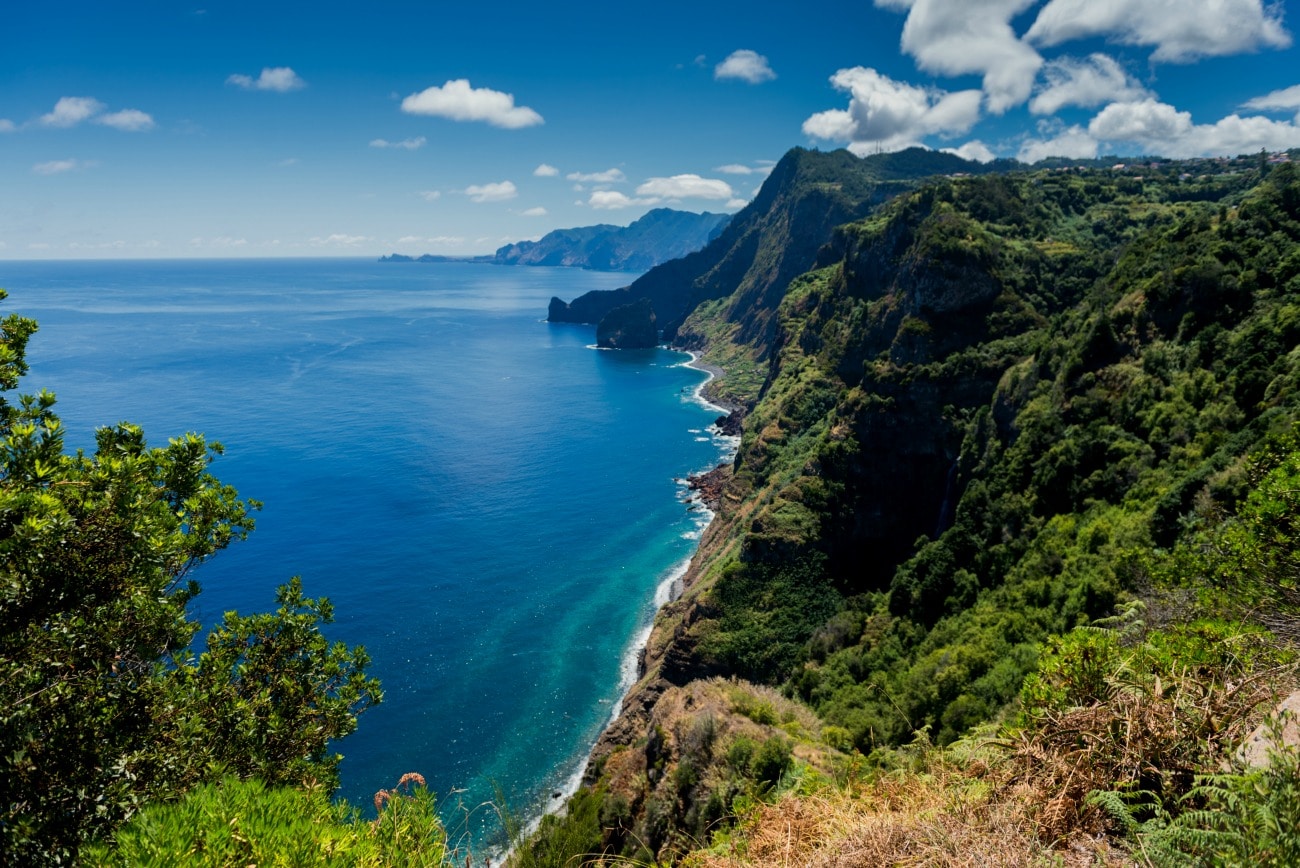The dramatic sunrise on the volcanic island of Madeira is one of those memories that will stay with me forever. After waiting for what seems forever, the quiet is suddenly interrupted by birds chirping, accompanied by a dramatic color change in the sky from black to orange against a calm ocean. I’m on top of Pico do Arieiro, the island’s third highest mountain and it’s a magical place to witness the dawn break.
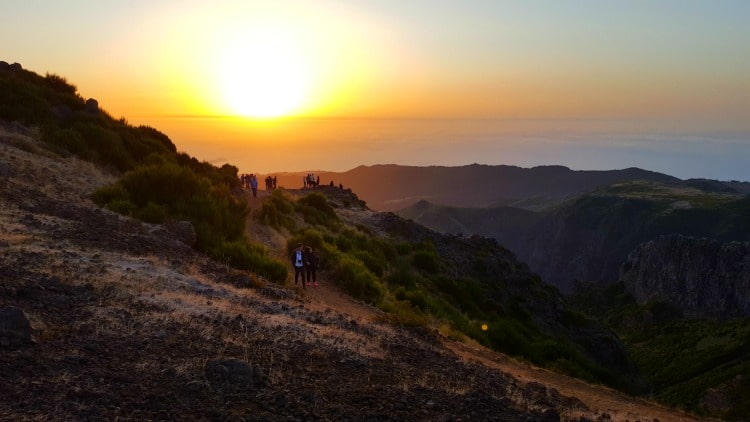
Locating Madeira
Madeira lies about 360 miles off the west coast of Africa or 90 minutes by plane from Lisbon. Compared to some other well-known European islands like Ibiza or Mallorca, it doesn’t have a reputation for being a party destination. Instead, it exudes a peaceful and serene atmosphere. Rugged cliffs rise steeply from the sea accentuated by colorful dragon trees and the air is almost sweet from the presence of evergreen flora and fauna, as well as the lush flower gardens.
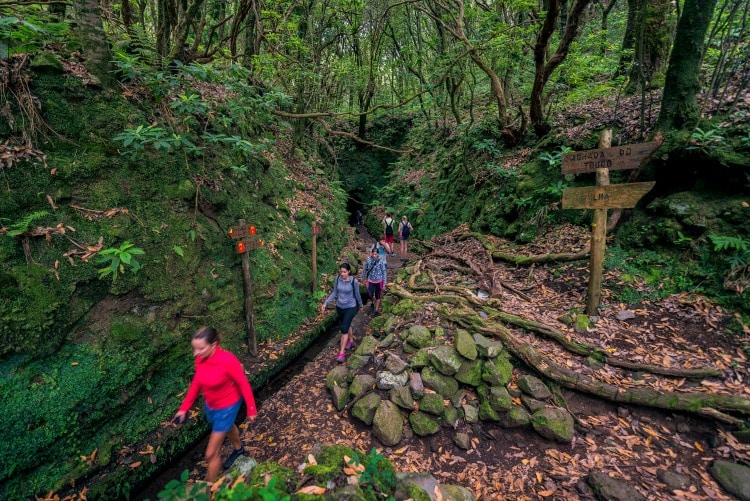
Hiking in Madeira
Following the flow of the freshwater, I join a group of hikers on my first levada walk later in the afternoon. Levadas are man-made irrigation channels dug into the rock to carry water from the mountains to the lower lying farmlands, a system that still works today. “I pay a very small fee for my levada water” says guide Fabio Castro. “For that I get a weekly, hourly slot during which the water gets diverted to my property. I can irrigate my garden but also store any excess water.”
There are hundreds of miles of levada walks, many of them passing through the over 50-million years old Laurissilva Forest, a precious natural environment which is only found in Madeira, the Azores and the Canary Islands. I walk next to the gently sloping water channels past some indigenous vegetation before breaks in the trees reveal views over grand gorges. Before long, I’m sprayed by rushing waterfalls and swallowed again by jungle.
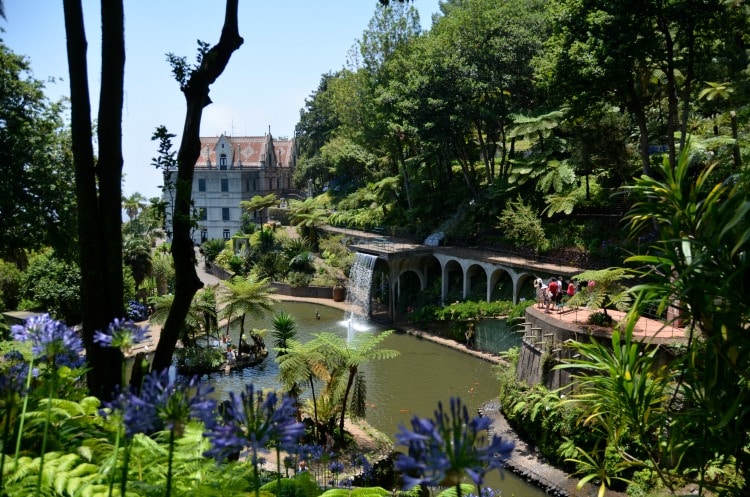
Madeira’s Natural Resources
Madeira has a subtropical climate, thanks to the Gulf Stream, which resulted in a wide variety of flora including some rare orchid species. On the island’s plantations there are bananas, avocados, custard apples, cherries and papaya. “My pregnant wife is craving these”, laughs Castro as he pockets a handful of banana passionfruit.
The island’s natural and introduced resources as well as its geostrategic position made it an important port of call in the Portuguese Maritime Expansion, and subsequent discovery of new worlds, in the 15th and 16th centuries.
It is believed that explorer João Gonçalves Zarco, who discovered Madeira just over 600 years ago in 1419, named the island which means “timber” or “wood”. Colonization began soon after, and the introduction of agricultural crops such as cereals and sugar made the capital Funchal an important commercial hub. Today the city is famous for being the birthplace of the world-renowned soccer player Cristiano Ronaldo after whom its airport is named. There is even a museum on the island to pay homage to one of the biggest talents (and egos) known in the world of soccer.
Spirits of Madeira
Long before Ronaldo, Madeira was always known for its sweet wine, which like some of the world’s greatest things, came about by accident. When a small amount of distilled alcohol from cane sugar was added to prevent the grapes from spoiling during long sea voyages, a wonderful chemical reaction from the heat of the ship’s hold gave birth to Madeira wine as we know it today.
However, its fortified charms are lost on me and instead I take a shining to the islanders’ local drink. Madeirans process their small sugar-cane crop into a sweet distilled liquor called aguardente de cana, then mix it with fresh lemon and honey into a cocktail called poncha. It’s delicious!
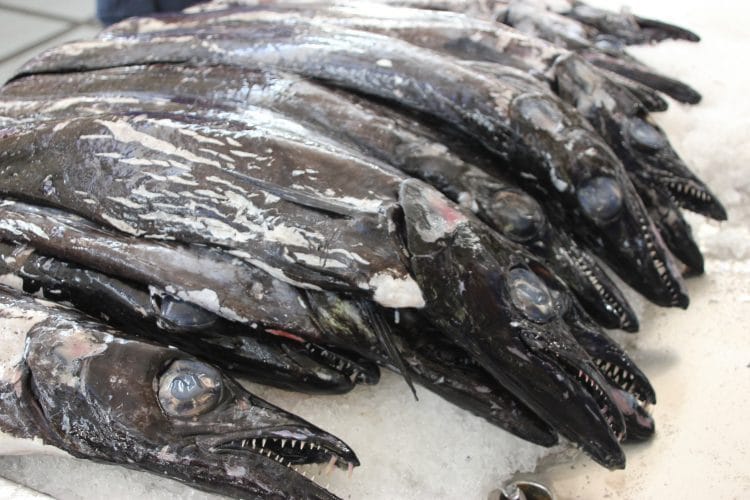
More Local Specialities
Another delicious local specialty is a meal of fried black scabbard with banana. The fresh fish are sold at the Mercado dos Lavradores, Funchal’s famous farmer’s market. I wonder about the eerie, zombie-like appearance until a fisherman explains that black scabbard is a deep-water predator and its eyes turn milky when brought up from the depths of the ocean.
Several times I try to find Madeira cake on the menu but to no avail. “Madeira cake as you know it has nothing to do with our island,” laughs a Madeira local, Luís Gonçalves. “It was actually named after Madeira wine with which it was served in England in the 18th century.” He directs me to Fabrica Santo Antonio where the traditional Madeira cake – bolo de mel, a dark, spicy, honey cake – has been made since 1893. “When we serve it, it is customary not to cut the cake, but rather to tear pieces off by hand”, explains the shop assistant.
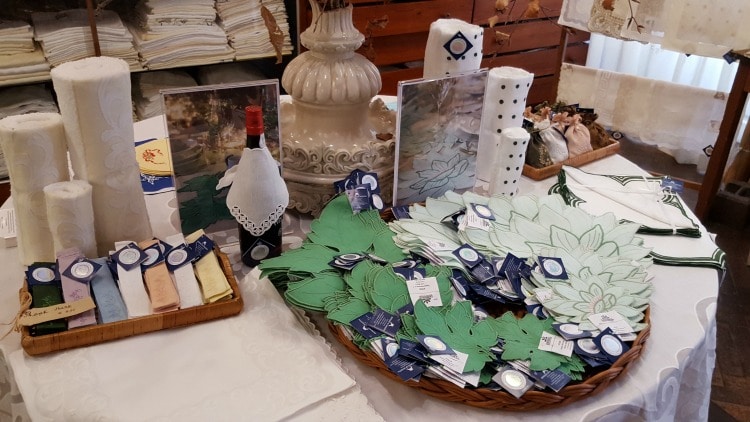
Madeira Embroidery
An even older tradition is Madeira embroidery which dates to the early days of colonization, but it wasn’t until the second half of the 19th century that the fabric was sold offshore. English traders established in Funchal began exporting embroidered pieces to England with Germany and America afterword.
“Unfortunately, ours is a dying art”, says Marcia Gomes at the Bordados da Madeira. “We have about 400 women working for our company on the island but the youngest is 45 years old and embroidery isn’t taught in the local schools”. The women pick up the fabrics such as linen, natural silk, organdie or cotton at the factory in Funchal, then return it completed to be paid by stitch. The most expensive item on sale is a tablecloth for $4000 which takes a year to finish.

More to See
Clearly too big for my hand luggage (or pocket) I buy a small lavender bag instead.
With purchase in hand and muscle aches from hiking, I choose to forego yet another climb in the steep hills of Funchal and instead take the cable car up to the hilltop district of Monte. Gently gliding up in 15 minutes, I’m rewarded with sweeping views of the ocean, the city outskirts and surrounding mountains. Atop, I stroll through Monte Palace Madeira, a tropical garden with a huge exotic plant collection.
But what goes up must come down, so I book a ride in a two-seat wicker toboggan. What was once an alternative way for wealthy residents to be transported quickly downhill is now a must-do activity for visitors. I place my life in the hands or rather the rubber-soled boots of the two carreiros and plummet down one of the steepest roads ever. The ride only takes about three minutes, but it’s got my heart pumping. Back at the hotel, I have a poncha. Now that’s an excitement I’m happy to repeat, just like watching another sunrise on Madeira.
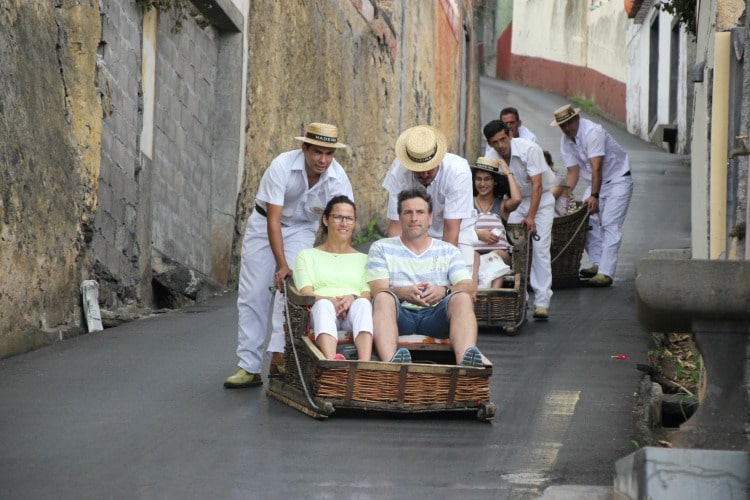
The country code for Portugal is 351.
[alert type=white]
Where to Stay
Quinta do Furão – This cozy old manor house is perfectly placed for walkers and nature lovers. Surrounded by vineyards, fruit trees, herbs and a variety of native plants both the hotel and the highly acclaimed restaurant have stunning views of the coastline on one side and Madeira’s highest mountains on the other. The property (with just 45 rooms) also offers a heated indoor/outdoor swimming pool, sauna, whirlpool, fitness and massage rooms and the Four Season Bar. www.quintadofurao.com
Where to Eat
Adega da Quinta – For the traditional Espetada Madeirense a visit to this restaurant, where the grilled beef skewers are hung from long metal poles above the table, is a must. Located in Funchal, Adega da Quinta specializes in Madeira’s typical country food. www.quintadoestreitomadeira.com
What to Do
Levada walk – Hiking the ancient levadas, irrigation channels which were dug to bring rainwater to Madeira’s low lying farmland, is the top outdoor activity. There are several hundred miles of trails. www.madeira-adventure-kingdom.com
Funchal cable car – The best views of Funchal encompassing the blue sea, the city outskirts and surrounding mountains happen during the 15 minutes of the 1,902ft high cable car ride from the Old Town to Monte station. https://madeiracablecar.com
Toboggan– Travel downhill in a two-seat wicker toboggan sled guided by two men, or carreiros, who use their rubber soled boots as brakes. The staggeringly steep 1 mile descent at up to 23 mph is an adrenalin-filled ride like no other. www.carreirosdomonte.com
Off-road tours – Exploring by 4WD is a great way to get to know the island, especially as the volcanic terrain covered in a dense forest is often difficult to access. The tours are usually half or full day and many stop in Santana, a small village with traditionally thatched triangular houses. www.discoveryisland-madeira.com
Water sports – Sea lovers will benefit from the warm sea currents, with year-round temperatures ranging between 66ºF to 75ºF, ideal for snorkeling, diving, sailing, paddle boarding, windsurfing and sport fishing.
Whale and dolphin watching – In this corner of the Atlantic there are 28 species of dolphins and whales including bottlenose dolphins, sperm whales and pilot whales that live in or visit the waters off the coast.
[/alert]

